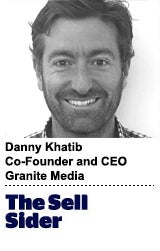“The Sell Sider” is a column written by the sell side of the digital media community.
Today’s column is written by Danny Khatib, co-founder and CEO at Granite Media.
It’s 2020, and we still have both supply-side platforms (SSPs) and demand-side platforms (DSPs) standing in the way of buyers and sellers, each taking a 15-20% cut and confusing the heck out of the web ecosystem in the process.
Meanwhile, publishers compete with walled gardens that have zero intermediaries instead of two. Why on earth are we still here, and what’s it gonna take to simplify this setup?
There is a commonly held belief that somehow the programmatic Force is held in balance by having opposing advocates for buyers and sellers alike, hence the need for an SSP and a DSP entering into an exchange with one another. I don’t think this has ever been true, and the fallacy becomes more obvious every day.
Publishers don’t really think of SSPs as their advocates or exchange agents, they think of them as the first link in the demand chain. Consider the current SSP playbook. Instead of publisher yield optimization, we’ve got bid shading, traffic shaping and inventory quality – features that are buyer-centric. Instead of clean earnings and reliable payments, SSPs pass through all opaque demand risk without providing the means to manage it. Enter DSP deductions and sequential liability. SSPs manage their own pseudo auctions to meter the bidstream, but they don’t actually run publisher auctions – Prebid does that.
And I know I already said it, but it bears repeating: bid shading? Seriously? This is the publisher advocate?
In the direction of seller to buyer, it seems pretty clear everything is a link in the demand chain, and everyone desperately wants to move at least one link closer. From the publisher perspective, most SSP demand is utterly non-unique – a problem that, let’s be honest, publishers helped create by exploding endpoints.
So publishers must look further upstream to actually manage and facilitate demand. They struggle with the lack of DSP-level transparency across all the endpoints and are waking up to the fact that DSP relationships and preferential decisions are more important than ever. Meanwhile, SSPs cozy up to DSPs with new features but also try to shore up unique budgets by cutting supply-path optimization (SPO) deals directly with buyers (agencies and brands), instead of relying on DSPs for this crucial part of their go-forward strategy to develop demand uniqueness.
In short, publishers want to work with DSPs directly, and SSPs want to work with buyers directly.
In the direction of buyer to seller, it gets a little more interesting but is similarly screwed up. It’s fair to say that a legitimate DSP is actually a buyer advocate. It has one primary job: to help buyer campaigns fill and perform. SSPs are their first supply link, and publishers are a subsequent supply link. This double link to supply is problematic. Enter bid duplication, obfuscation, absurd log-sharing requirements and more.
Of course DSPs should be doing SPO, but that problem hasn’t been easy to solve for a couple of reasons. First, there’s a trust issue. It’s a scary thing to put all your eggs in a couple of baskets you don’t own, especially when the basket owners might skip town (bankruptcy) and when they used to take some eggs away without telling you how many eggs they took (hidden margins). Second, there’s a performance issue. It’s a well known but not often discussed fact that from the buyer perspective, SSPs weirdly present themselves as having unique supply, even across identical domain sets. How so? The third-party cookie. DSPs rely on SSPs for cookie syncs and end up with larger overall cookie match rates when they bid across multiple SSPs. Therefore, overly aggressive SPO can actually hurt.
But now we have the death of the third-party cookie. If SSPs can’t provide unique cookie resolution, then all of a sudden, what’s the value in bidding on the same domains through multiple SSPs? And how will DSPs manage frequency capping? Could the death of the cookie be the final nail in the coffin of this crazy value chain? Maybe!
As we move into the next round of identity resolution conversations, we should not miss the opportunity to collapse the SSP-DSP intermediary link once and for all. But in which direction? The simple unavoidable fact is that in our current value chain, demand flow is inherently unique, and supply isn’t. You can’t spend the same dollar twice, but you can offer the same ad impression repeatedly. DSPs should clearly be working with publishers directly, and vice versa.
DSPs would continue to advocate for buyers, and publishers would be completely fine with this (they don’t need their own advocate). DSPs could maintain one distinct connection to publisher inventory, keeping all their eggs in their own basket. They could handle identity syncs, network optimizations and bidstream markup with their own “code on page” via Prebid adapters. All of a sudden, frequency capping might actually work again.
Publishers would also use Prebid to uniformly manage their end of the user resolution and bidstream markup processes, either client- or server-side. One less party takes 15-20% of the working media spend. Exit bid duplication, SPO, sequential liability and so many other headaches. Hello, more transparency and better margins. Hello, sanity.
To be clear, when I refer to DSP-direct, I’m referring to the role of the DSP. It’s entirely possible that existing DSPs could build the means to go publisher-direct. They would need to find some horizontal solutions for brand safety and billing (already doable), build out reporting and private marketplace functionality (needs work) and invest in account management (needs resources but less than people think). The SSPs are actually relatively strong in all of these areas. But for SSPs to go upstream and become DSPs, they’d need to build out ad-server logic (nontrivial), client-side reporting and billing (doable) and more account management (more than what’s already in progress).
It would be fun to see both sides of the link attempt this consolidation. Let’s hope that a few of the larger DSPs lead the way by building their own direct solutions at scale, beyond a few tests. Let’s hope another couple of large SSPs throw a Hail Mary and buy a midsize DSP before it goes bankrupt. (Not after, please!)
Finally, just to address one common argument head-on, over the years we have seen some companies try to house SSP and DSP businesses under the same roof, only to eventually split them out. This is not the type of consolidation I’m talking about here – those consolidation plays maintained separate products and still suffered from all the same ecosystem problems listed above.
There really shouldn’t be a traditional SSP business separate from a DSP business – that distinction no longer makes sense, if it ever did.
Follow Danny Khatib (@khatibda), Granite Media (@Granite_Media) and AdExchanger (@adexchanger) on Twitter.














